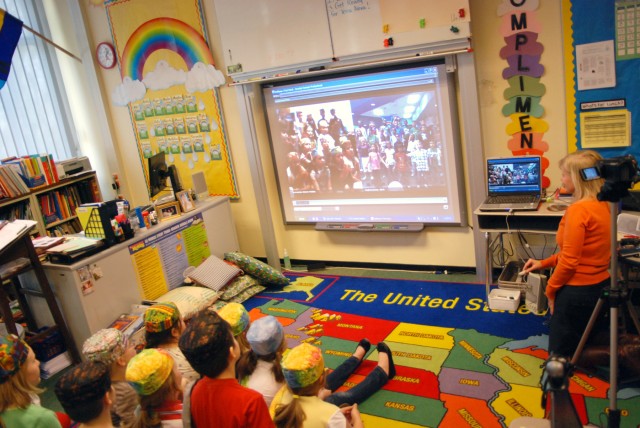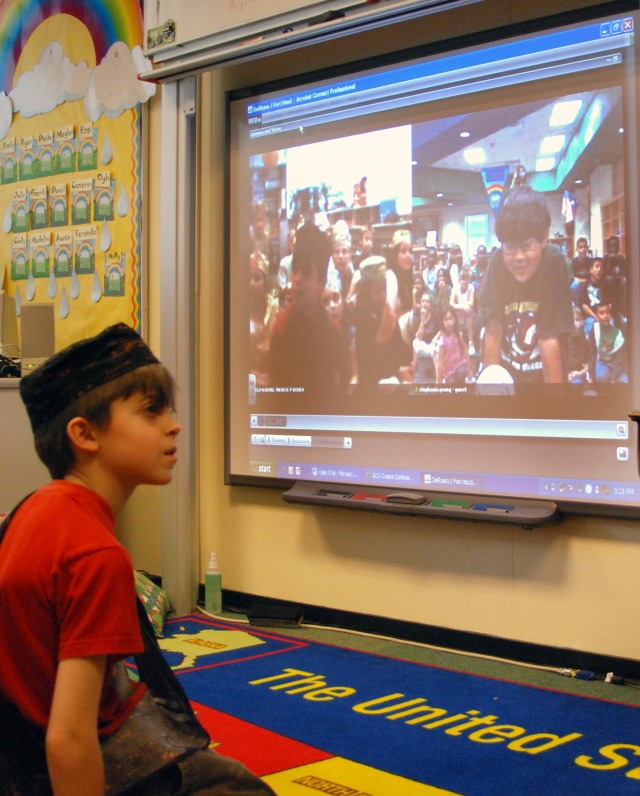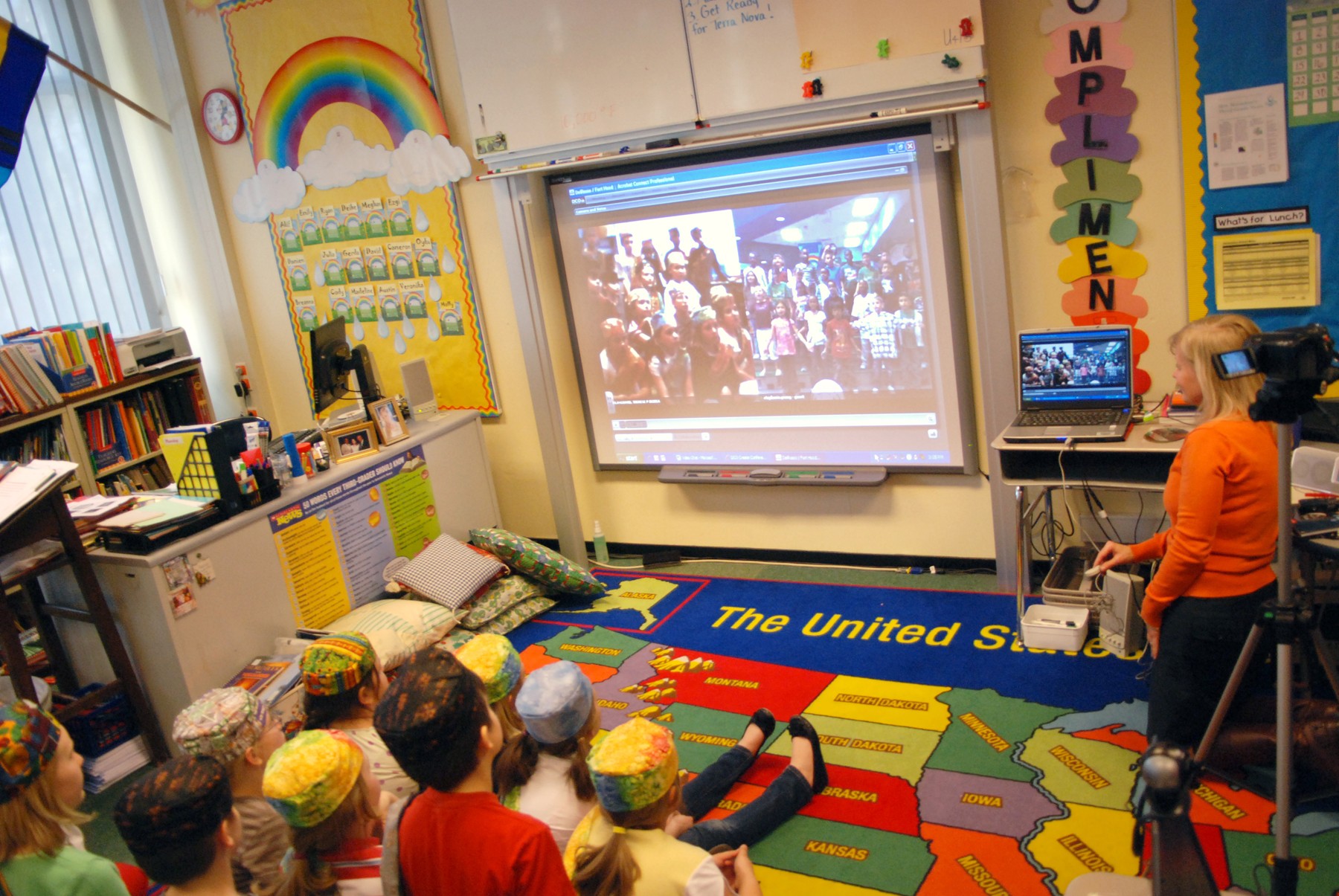MONS, Belgium - Third-graders in Belgium are visiting a school that's 5,000 miles away. They're putting on concerts, showing off their school projects and mingling with other military kids their age, but they're doing it all without even leaving their classrooms.
The students are part of SHAPE Elementary School's latest interactive learning tool - Video Teleconferencing.
"The novelty of being on camera and communicating directly, in real time, to students thousands of miles away, in a time zone seven hours behind us - it's significant," said Anthony Del Rosso, a third grade teacher at SHAPE.
"Military children benefit greatly from things that bring them closer to home and promote a sense of normalcy in their lives," he added. Del Rosso's class is one of many that are linking up with Meadow's Elementary School at Fort Hood, Texas.
Stephanie Young, the campus technologist for Meadows, had arranged interschool education activities before with other schools in Texas and a school in Michigan, but never had she branched outside the U.S.
She said she wanted to connect her students to others throughout the world.
"I believe that giving students the opportunity to talk with students their own age will give them a better understanding of the world," she said. "Sharing ideas, passing on information - likes and dislikes - with other students will give both parties a more lasting impression of their studies than simply doing research on the Internet."
Her dream to go abroad came true March 6, as the schools connected virtually for the first time.
"What's it like in Belgium'" one Meadows student asked.
"It's very rainy and cold all the time," answered a SHAPE third-grader in Libby Heineken's class.
As a student in Belgium asked if the kids at Fort Hood wore shorts, many stood up, showing off their warm-weather outfits. "No fair," a student said, and they all laughed.
But the SHAPE students got them back when they told the students at Meadows that they eat Belgian waffles and chocolate all the time and that it was already Friday afternoon and that their school week was almost over.
In addition to questions and answers, each class performed two songs for each other.
"I'm hoping this is just the beginning," said Therese Blanchard, SHAPE's educational technologist who helped make the connection with Young. "There's something about having a real audience for children. It inspires them to want to do more. It's an intrinsic motivator."
According to Young, the schools are planning many more projects together.
"Therese and I are currently planning a reading critique slideshow. It will have a small advertisement of the students' favorite books and a little synopsis from the students, as well," she said. "One of my second grade classes will learn French from a middle school student in Belgium. Two third grade classes will do a joint project on the rainforest. We have also talked about having a fifth grade class read to a Kindergarten class.
"Collaboration and communication is a key element to the future career of any child," Young added. "These VTCs show students that they can team with students from other cultures and countries all over the world. I feel that doing these projects virtually lets the students know that the sky is the limit."
Del Rosso said the VTCs offer another benefit to military children in Belgium.
"I think we lose sight of the fact that we have American kids who may have never been to America before. All they know of the U.S. is what they see in TV and movies," he said. "VTCs give everyone a glimpse into real America. In real time. Powerful."
The VTCs also benefit the international students who attend SHAPE American Elementary. Heineken has five in her class.
During the class' first VTC, Gerda Koidumae, from Estonia, and Akif Aday, from Turkey, both talked to the students from Fort Hood. With the switch of a button, the white board that was being used as the VTC monitor was instantly visible to Meadows' students.
Koidumae and Aday each wrote hello in their native language on the board, so the students in the States could see it. Then, they taught the kids how to say the word.
When the students left class immediately following the VTC, Heineken said, they were very excited to share the news with their parents. Young said the feedback she received was "absolutely wonderful."
"The students were just in awe of how much the students in Belgium are like them," she said. "Because of Belgium's location, they were surprised that Belgium had the same days as we do. The teachers and parents were very impressed with the VTC and look forward to more."
Based on Young and Blanchard's obvious passion, more is definitely to come. The two, who were initially linked up by the U.S. Army NATO SHAPE Battalion and Col. Gerald Daniels, the III Corps G6, worked through many technological obstacles to meet network requirements. They're continuing to experiment with their communication software to offer the students the greatest educational benefits.
Del Rosso, a self-proclaimed technophile, said the opportunities are limitless. He hopes that in the future classes will be able to stream activities and that experts can give interactive lessons.
"When a school has a fabulous guest speaker, stream it live for other classes to see. Have someone there who can ask questions on the world's behalf. Actual can replace virtual," he said. "Instead of reading a transcript of a chat, we could just watch the q and a live, and ask questions, to boot. We have the ability now. We just need the interest to drive the funding.""




Social Sharing